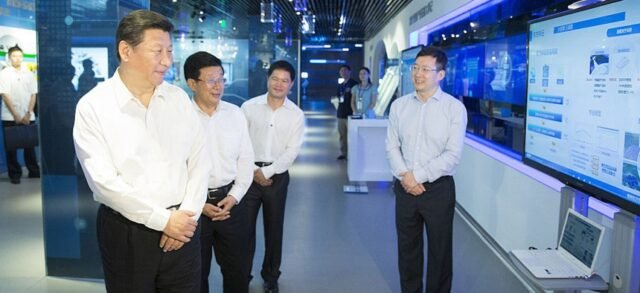In a strategic move to dominate the global artificial intelligence landscape, China has committed nearly $100 billion to national AI development. This monumental investment—recently confirmed by Chinese authorities—signals Beijing’s intent not only to expand its technological prowess but also to outpace Western rivals in the emerging AI frontier.
The ramifications of China’s aggressive strategy are reverberating across the Atlantic. In Washington and at state capitals coast to coast, educators, policymakers, and legislators are re-examining U.S. education systems and innovation policies in light of this accelerated AI competition. At the heart of the debate: How must American schools and universities adapt—if they are to avoid being eclipsed?
Table of Contents

China’s Grand AI Strategy: A $100 B Bet on the Future
China’s investment—spanning government coffers, state-owned giants, and large private firms—aims to position it as the unassailable leader in AI. From smart cities to military systems, China is scaling AI integration across sectors. Their focus spans military‑civil fusion, where insights from commercial AI are swiftly integrated with defence mechanisms.
That includes bolstering foundational infrastructure—expanding data centres, energy capacity, and semiconductor research—mirroring the integrated industrial push launched under the “Made in China 2025” and sustained through the Integrated Circuit Fund with over $95 billion in assets.
U.S. Schools Under Pressure: AI Education as the New Frontier
Beijing’s investment has reignited calls across the U.S. to weave AI into educational systems—from kindergarten to college—to preserve America’s tech dominance. The education policy echo is unmistakable: “This is our Sputnik moment,” said Loni Mahanta of The 74Million, drawing parallels with the U.S. response to the USSR’s Sputnik launch in 1957 The Times of India+3the74million.org+3The Times of India+3.
Already, initiatives are bubbling up. Ohio, for example, is rolling out teacher training programs and district-level AI policy toolkits. Nationally, states are funding AI-adaptive curricula, while university hubs align more deeply with industry partners to foster tech innovation and workforce readiness .
Education, Innovation & Security: An Intertwined Triad
The U.S. government and leading think tanks are increasingly treating AI as a cross-border strategic imperative, spanning economic strength, national security, and geopolitical influence.
The Senate’s Innovation & Competition Acts (USICA, CHIPS and Science) earmarked more than $100 billion for AI and adjacent tech over five years.
Yet despite this financial muscle, China’s simultaneous advancement in energy, infrastructure, semiconductor capacity, and policy coordination presents a compelling challenge. For instance, Republican-led movements recently rolled back U.S. clean‑energy tax incentives, while China surged ahead in adding more new solar and wind energy in just the first five months of 2025 than the U.S. did in all of 2024 washingtonpost.com.

From Curriculum to Classroom: What U.S. Schools Must Do
Embed AI Across the Curriculum
Just as China mandates AI instruction from elementary school onward, U.S. districts are urged to embed AI literacy—data science, ethics, algorithmic thinking—across traditional subjects.
Empower and Train Teachers
Teaching AI effectively hinges on teacher preparedness. Professional development for educators must scale quickly, similar to Ohio’s district workshops.
Invest in School Infrastructure
Modern AI education demands capable infrastructure: computing hardware, internet access, cloud tools, and partnerships with industry or higher education.
Bridge to Vocational + University Training
Schools need clearer pathways into AI‑related STEM careers—via vocational tracks, internships, dual enrollment, and stronger ties to universities and industry.
e. Democratize Access & Equity
Without thoughtful planning, AI education could exacerbate socio-economic divides. Policymakers must ensure equitable access to advanced resources and instruction.
The Innovation Ecosystem: Government, Industry & Academia
The U.S.’s AI capacity thrives on tri-sector collaboration. Funding and policy must incentivise:
- Joint research hubs between universities and industry.
- Regional tech clusters, mirroring the M-14 corridor, to embed AI in regional economies.
- Regulatory frameworks that support innovation while safeguarding values.
Echoing China’s central coordination strategy, U.S. actors are advocating for national oversight, similar to 2024’s federal AI executive order, the Senate roadmap (with bipartisan calls for $32 billion/year for non-defence AI R&D), and the pending USICA implementation
Lessons from Europe and Asia: A Global Push on AI Education
China is not alone. Globally, nations like Finland, South Korea, Singapore, Canada, and several EU states have integrated AI into K‑12 education or launched national strategies. The U.S. risks falling behind if it fails to respond with urgency and nuance.
The Stakes: National Security, Economy & Values
National Security
Advances in AI-powered defence—intelligence, threat detection, and autonomous systems are growing globally. China’s rapid progress in integrating AI with military systems highlights perceived vulnerability without a robust U.S. response.
Economic Competitiveness
AI will be central to the Fourth Industrial Revolution: driving productivity, creating new markets, and transforming jobs. Without cultivating homegrown talent, the U.S. could see offshoring of innovation to nations like China that are pulling ahead.
Democratic Values
The U.S. has the opportunity to shape AI in alignment with privacy, fairness, and transparency. To lead, America must pair technological edge with ethical frameworks.

Looking Ahead: What Comes Next
Federal Leadership: Congress and the White House must convert broad bipartisan consensus into definitive follow-through, accelerating USICA/CHIPS, clean-energy deployment, and AI workforce incentives.
State & Local Action: Education agencies and districts must accelerate AI literacy programs, facilitate teacher development, and share best practices.
Private-Public Synergy: Industry leaders can seed local education ecosystems through partnerships, similar to U.S. university-centric innovation zones.
Global Collaboration: Weighing cooperation with China in areas like AI safety and governance—while safeguarding national innovation—remains a delicate diplomatic challenge.
Conclusion: The Time for American AI Renewal is Now
China’s $100 billion AI investment is more than just a headline—it’s a signal that AI supremacy isn’t assured. In response, the U.S. must urgently recalibrate its investment in education, infrastructure, policy, and capacity-building—especially in K‑12 and higher education. Our future competitiveness, security, and leadership hinge on it.
Join Our Social Media Channels:
WhatsApp: NaijaEyes
Facebook: NaijaEyes
Twitter: NaijaEyes
Instagram: NaijaEyes
TikTok: NaijaEyes
READ THE LATEST EDUCATION NEWS





